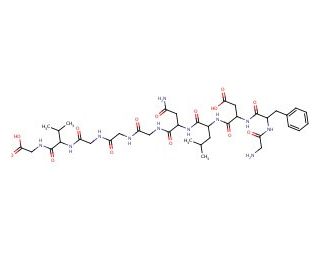

Speract (CAS 76901-59-2)
QUICK LINKS
Speract is a peptide hormone found in sea urchin sperm and is involved in the process of fertilization. Research on Speract has predominantly focused on its role in sperm-egg interactions and fertilization mechanisms. Mechanistically, Speract acts as a chemoattractant and acrosome reaction inducer, guiding sperm towards the egg and facilitating the fusion of sperm and egg membranes. Studies have explaind the specific receptor for Speract on the egg membrane, known as the Speract receptor, which triggers intracellular signaling cascades leading to changes in egg membrane potential and the release of egg-derived chemoattractants. Furthermore, Speract has been investigated for its structural features and binding kinetics to better understand its interaction with the egg membrane receptor and its specificity for sea urchin sperm. In research settings, Speract has been utilized as a tool to study the molecular mechanisms underlying sperm-egg recognition and fusion, offering insights into the fundamental processes of fertilization. Additionally, Speract analogs and inhibitors have been developed based on its structure, which could be valuable for manipulating sperm-egg interactions in experimental models and potentially for understanding fertilization in other species. Overall, Speract serves as a crucial research tool in reproductive biology, contributing to our understanding of the molecular events governing fertilization.
Speract (CAS 76901-59-2) References
- Real-time measurements of the interactions between fluorescent speract and its sperm receptor. | Nishigaki, T. and Darszon, A. 2000. Dev Biol. 223: 17-26. PMID: 10864457
- Egg fucose sulfate polymer, sialoglycan, and speract all trigger the sea urchin sperm acrosome reaction. | Hirohashi, N. and Vacquier, VD. 2002. Biochem Biophys Res Commun. 296: 833-9. PMID: 12200123
- Speract induces calcium oscillations in the sperm tail. | Wood, CD., et al. 2003. J Cell Biol. 161: 89-101. PMID: 12695500
- Altering the speract-induced ion permeability changes that generate flagellar Ca2+ spikes regulates their kinetics and sea urchin sperm motility. | Wood, CD., et al. 2007. Dev Biol. 306: 525-37. PMID: 17467684
- Single cell imaging reveals that the motility regulator speract induces a flagellar alkalinization that precedes and is independent of Ca²⁺ influx in sea urchin spermatozoa. | González-Cota, AL., et al. 2015. FEBS Lett. 589: 2146-54. PMID: 26143372
- Speract, a sea urchin egg peptide that regulates sperm motility, also stimulates sperm mitochondrial metabolism. | García-Rincón, J., et al. 2016. Biochim Biophys Acta. 1857: 415-26. PMID: 26772728
- FRET analysis using sperm-activating peptides tagged with fluorescent proteins reveals that ligand-binding sites exist as clusters. | Arcos-Hernández, C., et al. 2016. J Exp Biol. 219: 508-15. PMID: 26889001
- Receptor-mediated activation of detergent-solubilized guanylate cyclase. | Bentley, JK., et al. 1988. Biol Reprod. 39: 639-47. PMID: 2904284
- Stimulation of sperm respiration rates by speract and resact at alkaline extracellular pH. | Suzuki, N. and Garbers, DL. 1984. Biol Reprod. 30: 1167-74. PMID: 6547354
Ordering Information
| Product Name | Catalog # | UNIT | Price | Qty | FAVORITES | |
Speract, 1 mg | sc-394430 | 1 mg | $80.00 |
